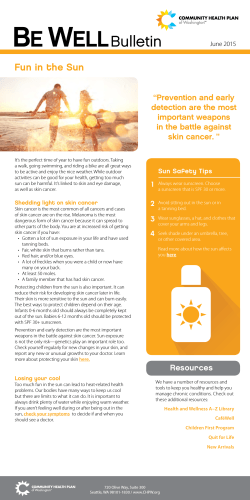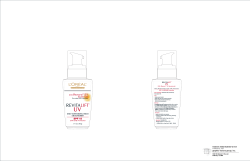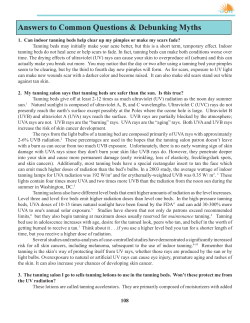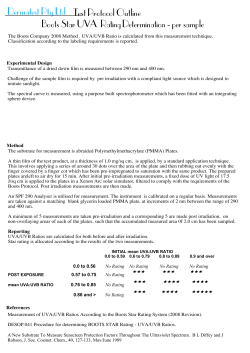
A U I
AU Inf rMed Volume 8 Number 5 (Issue 229) Friday, July 16, 2010 Guest Editors: Ashley M. Getting, Pharm.D. Candidate, Rachael A. Wommack, Pharm.D. Candidate Key Inforbits Eye Care UVA and UVB Choosing the Right SPF Alternative Sunscreen Measures Self-Screening for Skin Cancer Tanning Bed Risks The Risks of Sun Exposure: Every day you are exposed to the sun’s effects…when you walk your dog, check the mail, even when you drive your car. Although the sun is important as a source of vitamin D, what kind of protection are you providing for yourself? Sun overexposure can cause a number of adverse outcomes on your health, which include eye and skin cancer, premature aging, and even death. Melanoma skin cancer is the one of the most common forms of cancer in the U.S., with 68,130 new cases expected to be diagnosed in 2010, and 8,700 estimated deaths.1 Protecting yourself from the sun and its harmful effects is very important, as well as knowing what your skins warning signs indicate about the need to speak with your doctor. 1. Cancer Facts and Figures 2010 [Internet]. Atlanta, GA: American Cancer Society, Inc; c2010 [cited 2010 Jun 04]. Available from: http://www.cancer.org/downloads/STT/Cancer_Facts_and_Figures_2010.pdf Eye Care: We all know that our skin can burn from sun exposure, but did you know that your eyes can get sunburned too? While your eyes won’t turn red and peel like skin, they can get a surface burn that will go away in a few days like any other sunburn. However, this eye sunburn can lead to long lasting problems and promote the development of conditions like cataracts, cancers/growths of the eye, and age-related macular degeneration. During the month of July the American Academy of Ophthalmology promotes UV Safety Month to bring awareness of the effects that excessive UV exposure can do to your eyes. They offer the following tips to keep your eyes safe:1 Buy and wear sunglasses that block 99-100% of UVA and UVB rays. Just because a pair of glasses costs a lot does not mean it provides protection – be sure to check the tag!! Sunglasses that wrap around your temples block the UV rays from entering the sides and thus offer better protection – a must when you are boating or snow-skiing. Wear a wide brimmed hat that keeps the sun both off your face and out of your eyes – provides 2 for 1 protection. UV light is at its strongest from 10:00am to 4:00pm, even if it is gray and overcast outside. AU InforMed, vol. 8, no. 5, Friday, July 16, 2010 19 When sunlight reflects off of water, snow, or pavement it becomes intensified and much more dangerous Don’t forget that UV rays can be emitted from other light sources – tanning lights, welding lamps, etc – so use eye protection here as well Don’t forget about your children, their eyes need protection, too So, when heading out of the house grab your sunglasses and wide brimmed hat and be sure to use them. Your eyes will thank you. 1. AAO: July is UV Safety Month [internet]. San Francisco: American Academy of Ophthalmology; 2008 [cited 2010 Jun 03]. Available from http://www.aao.org/ UVA and UVB Protection: There are two types of ultraviolet (UV) radiation that can penetrate the skin and cause damage, including skin cancer. UVA rays penetrate deep into the skin and can cause wrinkling and other forms of premature aging, while UVB rays are more associated with sunburn. Since UVA does not cause reddening of the skin like UVB, damage can be done without burning. This is why it is important to have a sunscreen that protects you from both UVA and UVB exposure.1 Broadspectrum sunscreens protect the skin from UVA and UVB rays, and these sunscreens add chemicals like oxybenzone, avobenzone, and ecamsule to provide protection from UVA rays. Avobenzone absorbs long UVA wavelengths, but breaks down in the presence of UV radiation. Octocrylene and oxybenzone, which absorb shorter UVA wavelengths, can be used with avobenzone to help stabilize this breakdown. There are a number of products that take advantage of this. For example, some of Neutrogena’s® sunscreens contain a patented product called Helioplex, which contains avobenzone plus oxybenzone to prevent the breakdown and inactivation of the sunscreen. Another formulation that provides good protection against UVA and UVB radiation is Anthelios SX (ecamsule, avobenzone, and octrocrylene), which can be found in other sunscreen products. There are also sunscreens that contain titanium dioxide or zinc oxide that reflects UVA and UVB rays by acting as a physical barrier. These products are good for people that are allergic to sunscreens with chemicals, but some of these products may be cosmetically unacceptable to the user as they remain visible on top of the skin.2,3 1. 2. 3. Sunscreen [Internet]. New York: Skin Cancer Foundation; c2010. Sunscreens Explained. [cited 2010 Jun 1]; Available from: http://www.skincancer.org/Sunscreens-Explained.html Sunscreens/Sunblocks. [Internet]. American Academy of Dermatology; c2005. [cited 2010 Jun 3]; Available from: http://www.aad.org/public/publications/pamphlets/sun_sunscreens.html Update on Sunscreens: UVA protection. Pharmacist’s Letter/Prescriber’s Letter. 2007 Aug; 23(8):230806. Choosing the right SPF: Choosing the right SPF (Sun Protection Factor) is important since it can block UV rays from penetrating the skin. An SPF of at least 15 is generally recommended for adequate protection. SPF defines the sunscreen’s ability to block UVB penetration, and takes into account how long it takes skin that is unprotected to burn. For example, if you typically burn within 25 minutes of sun exposure, a sunscreen with an SPF of 15 should protect you from burning 15 times longer. This would mean you should be protected for 375 minutes, or a little over 6 hours. Despite this proposed protection, sunscreen at any SPF should not be assumed to remain effective past 2 hours.1 There are other factors that play a role in the amount of exposure to UV rays such as the time of day exposed and the type of skin you have. Therefore, sunscreen should be reapplied throughout the day and anytime after swimming, sweating, or toweling off.1,2 1. 2. Sunscreen [Internet]. New York: Skin Cancer Foundation; c2010. Sunscreens Explained. [cited 2010 Jun 1]; Available from: http://www.skincancer.org/Sunscreens-Explained.html Sunburn Protection Factor (SPF) [Internet]. U.S. Food and Drug Administration; 2009 Apr 30 [cited 2010 Jun 2]; Available from: http://www.fda.gov/AboutFDA/CentersOffices/CDER/ucm106351.htm AU InforMed, vol. 8, no. 5, Friday, July 16, 2010 20 Additional Methods to Protect Your Skin Although using sunscreen is an important part of protecting your skin, there are other preventative measures you should take to decrease your risk of skin cancer and aging. These include:1,2 Avoid tanning, tanning beds, and burning. Stay in shaded areas, especially between 10am and 4pm when the sun’s rays are strongest, however, remember to still use your sunscreen as the sun can be reflected off the water and sand into those shady areas. Cover skin with clothing and wear a wide-brimmed hat. Clothing is available with SPF built into the fabric. Always wear UV blocking sunglasses Self examine your skin every month, and see your doctor every year for a skin exam. Use preventative measures even in the winter. The snow can reflect the sun off of its surface and still cause damage to your skin. There are also important points to remember when applying your sunscreen:1 Always apply sunscreen with an SPF of at least 15 to the entire body 30 minutes before going outdoors. Use 1 ounce for each application, which should look like a half-dollar in your palm. Reapply sunscreen at least every 2 hours Use sunscreen for babies 6 months of age and older. Keep children younger than 6 months out of the sun and covered properly with clothing. 1. 2. Prevention Guidelines [Internet]. New York: Skin Cancer Foundation; c2010. Guidelines. [cited 2010 Jun 1]; Available from: http://www.skincancer.org/Guidelines/ Sunscreens/Sunblocks. [Internet]. American Academy of Dermatology; c2005. [cited 2010 Jun 3]; Available from: http://www.aad.org/public/publications/pamphlets/sun_sunscreens.html Self Screening for Skin Cancer The three major types of skin cancer include basal cell carcinoma, squamous cell carcinoma, and melanoma. Basal cell carcinoma is the most common form of skin cancer, while melanoma is the most serious and deadliest type. When skin cancer is diagnosed early and treated appropriately, it is one of the easiest forms of cancer to cure. When left untreated, it can have serious consequences that can include death. Monthly self exams are vital to recognizing early stages of skin cancer, and once yearly skin exams by your doctor are equally important. The Skin Cancer Foundation and the American Cancer Society suggest that during your monthly self exams, there may be warning signs that indicate you should see your doctor before your annual check-up. These include:1,2 A growth on the skin that increases in size and appears pearly, translucent, tan, brown, black, or multicolored A mole, birthmark, beauty mark, or any brown spot that: o Changes in color o Increases in size or thickness o Changes in texture o Is irregular in outline o Is bigger than 6mm or 1/4”, the size of a pencil eraser o Appears after age 21 A spot or sore that continues to itch, hurt, crust, scab, erode, or bleed An open sore that does not heal within three weeks. 1. 2. Self Examination [Internet]. New York: Skin Cancer Foundation; c2010. If You Can Spot It You Can Stop It. [cited 2010 Jun 1]; Available from: http://www.skincancer.org/Self-Examination/ Skin Cancer Prevention and Early Detection [Internet]. Atlanta, GA: American Cancer Society, Inc.; c2010 [cited 2010 Jun 07]. Available from: http://www.cancer.org/docroot/ped/content/ped_7_1_skin_cancer_detection_what_you_can_do.asp AU InforMed, vol. 8, no. 5, Friday, July 16, 2010 21 From the Medical Literature: Tanning Beds To tan or not to tan, that is the question? There are many differing opinions. The tanning industry advocates will tell you that tanning beds are at least less dangerous than actual sun tanning. They argue that in a tanning bed you can control your exposure1 and you can choose a tanning bed that emits very little to no UV-B radiation, which is supposed to be safer.2 However, despite these claims, the International Agency for Research on Cancer (IARC) has placed tanning devices in the highest cancer risk category: “carcinogenic to humans” as of July 2009. In support of this argument, a study has just been released with the results of the Skin Health Study. In this study the researchers looked at the relationship between indoor tanning and the risk of developing melanoma by looking at the frequency of tanning device use, the years of use, age of first use, and the specific devices used (UVA vs. UVB emitting). The results provided strong evidence that indoor tanning is a risk factor for developing melanoma and that risk was more associated with the cumulative total time spent tanning rather than at what age the first tanning exposure took place. The study also found that the risk of melanoma was increased with each type of tanning device suggesting that UVA or UVB emitting devices should not be considered safe.3 1. 2. 3. FDA: Indoor Tanning: The Risks of Ultraviolet Rays [Internet]. Silver Spring, MD: Food and Drug Administration; 2010[updated 2010 Jun 04, cited 2010 Jun 04]. Available from http://www.fda.gov/ForConsumers/ConsumerUpdates/ucm186687.htm All about Tanning Beds [Internet]. Tanning-Advisor.com; 2010 [cited 2010 Jun 04]. Available from http://www.tanningadvisor.com/tanning-beds.html Lazovich D, Vogel RI, Berwick M, et al. Indoor Tanning and Risk of Melanoma: A Case-Control Study in a Highly Exposed Population. Cancer Epidemiol Biomarkers Prev. 2010 Jun; 19(6):1557-68. The last “dose” … “You have to love a nation that celebrates its independence every July 4, not with a parade of guns, tanks, and soldiers who file by the White House in a show of strength and muscle, but with family picnics where kids throw frisbee’s, the potato salad gets iffy and the flies die from happiness. You may think you have overeaten, but it is patriotism.” - Erma Bombeck An electronic bulletin of drug and health-related news highlights, a service of … Auburn University, Harrison School of Pharmacy, Drug Information Center • Phone 334-844-4400 • Fax 334-844-8366 • http://www.pharmacy.auburn.edu/dilrc/dilrc.htm Bernie R. Olin, Pharm.D., Director Archived issues are available at: http://pharmacy.auburn.edu/dilrc/au_informed.htm AU InforMed, vol. 8, no. 5, Friday, July 16, 2010 22
© Copyright 2026





















